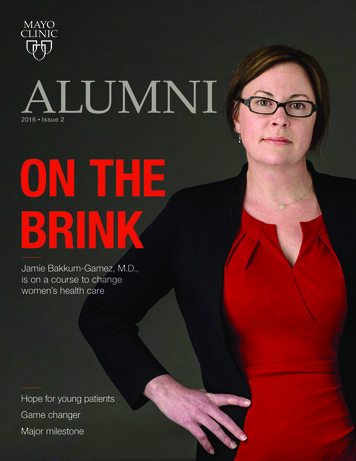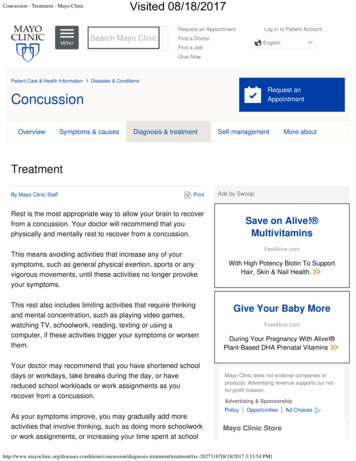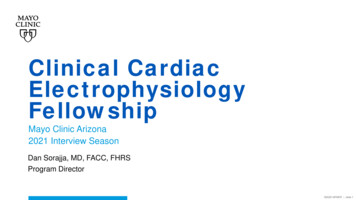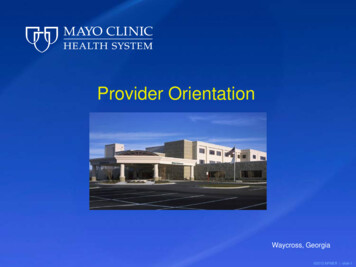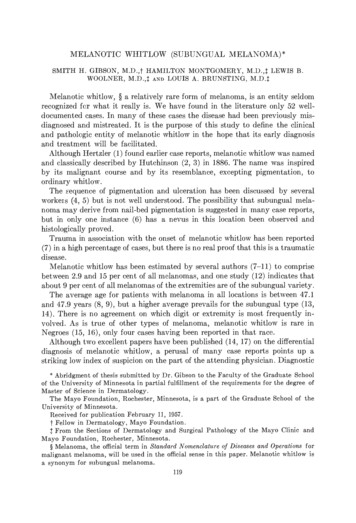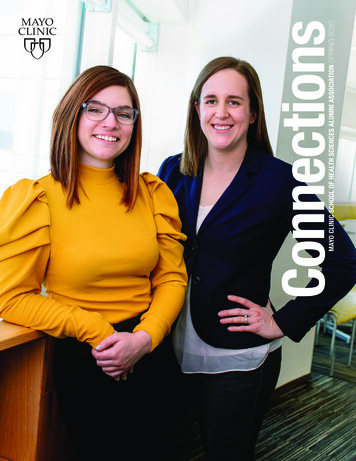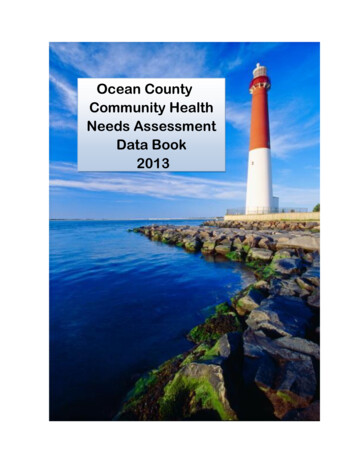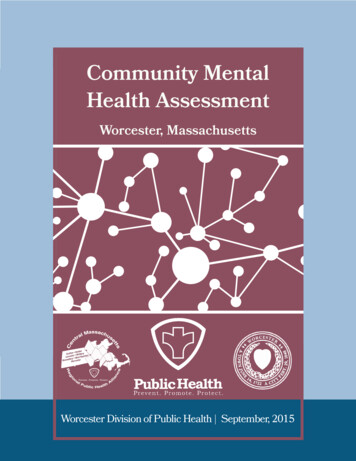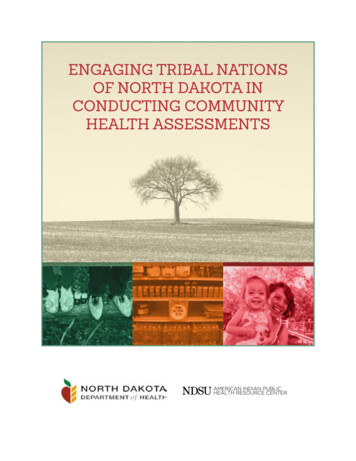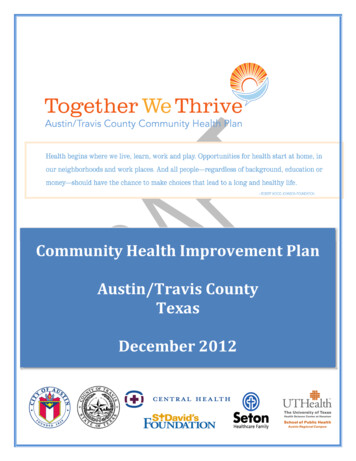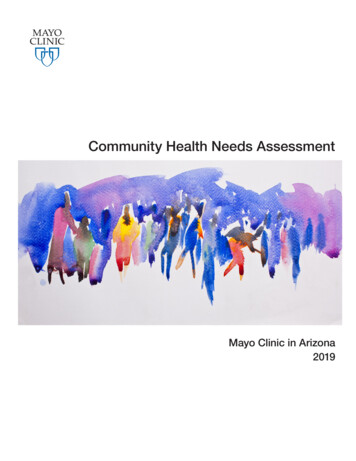
Transcription
Community Health Needs AssessmentMayo Clinic in Arizona2019
Maricopa County Coordinated CommunityHealth Needs AssessmentThis community health needs assessment report is a customized version of the coordinated community healthneeds assessment that the Maricopa County Department of Public Health (MCDPH) conducted in partnershipwith Adelante Healthcare, Banner Health, Dignity Health, Mayo Clinic, Native Health, and Phoenix Children’sHospital.June 21, 20192 Mayo Clinic Community Health Needs Assessment
Table of ContentsI. Executive Summary . 4II. Assessment Purpose and Organizational Commitment . . 7A. Organizational Commitment . . 7B. Enterprise Overview. . . 7C. Entity Overview. .7III. Community Definition . . 8A. Definition of Community . . 8B. Demographics of Community. 9IV. Assessment Process and Methods . . 10A. Secondary Data . . 10B. Primary Data . . 12C. Data Limitations and Information Gaps 17V. Identification and Prioritization of Community Health Needs.18A. Identifying, Process and Criteria for Prioritization. 18B. Description of Prioritized Community Health Needs. 18VI. Resources Potentially Available to Address Needs. . . 24VII. Impact of Actions Taken Since Preceding CHNA . 25VIII. Input Received on Most Recent CHNA and Implementation Strategy. 26Appendix A. List of Data Sources . 27A. List of Indicators . . 27Appendix B. Primary Data Collection Tools 31Appendix C. References . . 353 Mayo Clinic Community Health Needs Assessment
Executive SummaryCommunity Health Needs Assessment (CHNA) BackgroundThe Patient Protection and Affordable Care Act (ACA) added new requirements which nonprofit hospitals mustsatisfy in order to maintain their tax-exempt status under section 501(c)(3) of the Internal Revenue Code. Onesuch requirement added by ACA, Section 501(r) of the Code, requires nonprofit hospitals to conduct aCommunity Health Needs Assessment (CHNA) and adopt implementation strategies to meet the identifiedneeds of the community at least once every three years. As part of the CHNA, each hospital is required tocollect input from individuals in the community, including public health experts as well as residents,representatives or leaders of low-income, minority, and medically underserved populations.Synapse is a coalition of non-profit and federally-qualified health care partners who collaborate to conduct aCommunity Health Needs Assessment to identify needs for both individual hospitals, health care centers, andthe county overall. Beginning in early 2018, Mayo Clinic, in partnership with Synapse worked collaborativelyand conducted a community assessment of the health needs of residents of Maricopa County. The CHNAprocess undertaken and described in this report was conducted in compliance with federal requirements.Purpose StatementThe purpose of this Community Health Needs Assessment (CHNA) is to identify and prioritize significant healthneeds for the community served by Mayo Clinic Hospital. The priorities identified in this report help to guidethe hospital’s community health improvement programs and community benefit activities, as well as itscollaborative efforts with other organizations that share a mission to improve health. This CHNA report meetsrequirements of the Patient Protection and Affordable Care Act that not-for-profit hospitals conduct a CHNAat least once every three years.Community DefinitionThe geographic area for this CHNA is Maricopa County, the common community for all partners participatingin the Synapse coalition. Although the population served by Mayo Clinic in Arizona extends beyond the countyline and the borders of the state, most of our patients are located within Maricopa County. The remainingpercentage of Mayo Clinic patients are from the remaining zip codes in Arizona, the surrounding states of theSouthwest and a smaller, yet significant number of international patients.Maricopa County is the fourth most populous county in the United States. With an estimated population of 4million and growing, Maricopa County is home to well over half of Arizona’s residents. Maricopa Countyencompasses 9,224 square miles, includes 27 cities and towns, as well as the whole or part of five sovereignAmerican Indian reservations. Maricopa County is ethnically and culturally diverse, home to more than 1.2million Hispanics (30% of all residents), 216,000 African Americans, 157,000 Asian Americans, and 77,000American Indians. According to the U.S. Census Bureau, 14% percent of the population does not have a highschool diploma, 17% are living below the federal poverty level, and over 600,000 are uninsuredi .4 Mayo Clinic Community Health Needs Assessment
Assessment, Process and MethodsThe ACA requirements are mirrored in the Public Health Accreditation Board’s (PHAB) standard mandatingthat health departments participate in or conduct a community health assessment every three to five years.Federally funded community health centers must also ensure their target communities are of high need. Thesimilar requirements from IRS, PHAB, and the federally funded health center requirements put forth by theUnited States Department of Health and Human Services provide an opportunity to catalyze strongercollaboration and better shared measurement systems among hospitals, health centers, and healthdepartments. Additionally, limited resources for comprehensive health assessments and the move towardnew population health models have created the need for an organized, collaborative, public-private approachfor conducting assessments. As a result, Adelante Healthcare, Banner Health, Dignity Health, Mayo Clinic,Native Health, and Phoenix Children’s Hospital have joined forces with Maricopa County Department of PublicHealth (MCDPH) to identify the communities’ strengths and greatest needs in a coordinated community healthneeds assessment.The process of conducting this assessment began with a review of approximately 100 indicators to measurehealth outcomes and associated health factors of Maricopa County residents. The indicators includeddemographic data, social and economic factors, health behaviors, physical environment, health care, andhealth outcomes. Health needs were identified through the combined analysis of secondary data andcommunity input. Based on the review of the secondary data, a consultant team developed a primary datacollection guide used in focus groups which were made up of representatives of minority and underservedpopulations who identified community concerns and assets.Summary of Prioritization ProcessTo be a considered a health need, a health outcome or a health factor had to meet two criteria. First, existingdata had to demonstrate a worsening trend in recent years, or indicate an apparent health disparity. Second,the health outcome or factor had to be mentioned in a substantial way in focus groups and key stakeholdermeetings. Findings from primary and secondary data were reviewed and prioritized by the Mayo ClinicCommunity Engagement Committee, Mayo Clinic Diversity & Inclusion Committee, Mayo Clinic CommunityAdvisory Board, and were approved by the Mayo Clinic Arizona Executive Operations Team.Prioritized needsThe following statements summarize each of the areas of priority for Mayo Clinic and are based on data andinformation gathered through the CHNA.1. Access to Care: Appropriate access to care means everyone receives the services and support theyneed to maintain optimal health and wellbeing throughout their lives. This requires that care servicesbe obtainable, accessible, and affordable to all. Maricopa County community members and keyinformants overwhelmingly felt that access to care is an important issue for the community. WhenMaricopa County community survey respondents were asked, what was the most important “HealthProblem” impacting their community, access to care was their top concern. Fifteen percent ofcommunity respondents also indicated they had no health insurance coverage in 2016 and accordingto the 2017 Behavioral Risk Factor Surveillance Survey (BRFSS), 12.6% of Arizonians have no health5 Mayo Clinic Community Health Needs Assessment
insurance and 16.3% of Maricopa County respondents indicated they do not have health carecoverage.2. Cancer/Breast Cancer: While advancements continue to be made in the fight against cancer, it remainsthe leading cause of death in the United States, and for residents in Arizona and Maricopa County.Nationally, the most common cancers (listed in descending order according to estimated new cases in2018) are breast cancer, lung and bronchus cancer, prostate cancer, colon and rectumcancer, melanoma of the skin, bladder cancer, non-Hodgkin lymphoma, kidney and renal pelviscancer, endometrial cancer, leukemia, pancreatic cancer, thyroid cancer, and liver cancerii. In the stateof Arizona, cancer is a leading cause of disease burden, with an average of 85 new diagnoses everydayiii. Among women, specifically in the White and Black populations, breast cancer is one of the mostcommon cancers in Arizona and Maricopa County. Mayo Clinic prioritized breast cancer as a significantneed within the community based on statistical data and cancer being one of the health concernsexpressed by the focus groups.3. Social Determinants of Health (SDOH)/Homelessness: Social determinants of health are conditions inthe environments in which people are born, live, learn, work, play, worship, and age that affect a widerange of health, functioning, and quality-of-life outcomes and risksiv. Mayo Clinic is dedicated tomaking a positive impact on the social determinants of health, particularly on the health of those whoare experiencing homelessness. By focusing on SDOH, Mayo Clinic believes it will not only improveindividual and population health, but also advance health equity and quality of life.Resources Potentially AvailableResources potentially available to address identified needs include services and programs available throughhospitals, government agencies, and community-based organizations. Resources include access to more than40 hospitals for emergency and acute care services, more than 10 Federally Qualified Health Centers (FQHC),more than 12 food banks, 8 homeless shelters, school-based health clinics, churches, transportation services,health enrollment navigators, free or low cost medical and dental care, and prevention-based communityeducation.The Health Improvement Partnership of Maricopa County (HIPMC) is a collaborative effort between MaricopaCounty Department of Public Health (MCDPH) and a wide array of public and private organizations addressinghealthy eating, active living, linkages to care and tobacco-free living. With more than 100 partnerorganizations, this is a valuable resource to help Mayo Clinic connect to other community-based organizationsthat are targeting many of the same health priorities.vThis CHNA report was approved by the Mayo Clinic Arizona Executive Operations Team on December 12,2019.This report is widely available to the public on the hospital’s web site https://www.mayoclinic.org/, and apaper copy is available by request from Mayo Clinic Office of Public Affairs. Written comments on this reportcan be submitted to Marion K. Kelly, director Community & Business Relations, Mayo Clinic 13400 E. SheaBlvd., Scottsdale, AZ 85259, or by email at: Kelly.marion@mayo.edu.6 Mayo Clinic Community Health Needs Assessment
Assessment Purpose and Organizational CommitmentCommunity Health Needs Assessment (CHNA) BackgroundMayo Clinic is dedicated to enhancing the health of the communities it serves. The findings from thisCommunity Health Needs Assessment (CHNA) report will serve as a foundation for understanding the healthneeds found in the community and will inform the implementation strategies selected. This report complieswith federal tax law requirements set forth in Internal Revenue Code section 501(r) requiring hospital facilitiesowned and operated by an organization described in Code section 501(c)(3) to conduct a CHNA at least onceevery three years. With regard to the CHNA, the ACA specifically requires nonprofit hospitals to: (1) collect andtake into account input from public health experts as well as community leaders and representatives of highneed populations—this includes minority groups, low-income individuals, medically underserved populations,and those with chronic conditions; (2) identify and prioritize community health needs; (3) document aseparate CHNA for each individual hospital; (4) and make the CHNA report widely available to the public. Inaddition, each nonprofit hospital must adopt an Implementation Strategy that describes how the hospital willaddress the identified significant community health needs.Organizational CommitmentEnterprise Overview:Mayo Clinic is a not-for-profit, worldwide leader in patient care, research and education. Each year, MayoClinic serves more than 1 million patients from communities throughout the world, offering a full spectrum ofcare from health information, preventive and primary care to the most complex medical care possible. MayoClinic provides these services through many campuses and facilities, including 20 hospitals located incommunities throughout the United States, including Arizona, Florida, Minnesota, Wisconsin and Iowa.Mayo Clinic provides a significant benefit to all communities, local to global, through its education andresearch endeavors. Mayo Clinic reinvests its net operating income funds to advance breakthroughs intreatments and cures for all types of human disease and quickly bring this new knowledge to patient care.With its expertise and mission in integrated, multidisciplinary medicine and academic activities, Mayo Clinic isuniquely positioned to advance medicine and bring discovery to practice more efficiently and effectively.Through its Centers for the Science of Health Care Delivery and Population Health Management, Mayo Clinicexplores and advances affordable, effective health care models to improve quality, efficiency and accessibilityin health care delivery to people everywhere.Entity OverviewMayo Clinic Hospital in Arizona is the first hospital planned, designed and built by Mayo Clinic. Completed inthe fall of 1998, the hospital was designed to deliver high-quality inpatient medical care in an efficient, friendlyenvironment. The hospital is a seven-story facility with 268 licensed beds, 21 operating rooms and a Level IIemergency department. Emergency room services are available 24 hours a day.Mayo Clinic Hospital is in the northeast part of Phoenix, 14 miles from the Mayo Clinic campus in Scottsdale.The hospital provides inpatient care to support the medical and surgical specialties and programs at the clinic.Mayo Clinic Hospital serves patients in Maricopa County and from the surrounding area, as well as from all 50states and about 70 foreign countries annually.7 Mayo Clinic Community Health Needs Assessment
Community DefinitionDefinition of CommunityThe geographic area for this CHNA is Maricopa County, the common community for all partners participatingin the Synapse Partnership. Although the population served by Mayo Clinic Hospital in Arizona extends beyondthe county line and the borders of the state, many patients are located within Maricopa County. Theremaining percentage of Mayo Clinic Hospital patients are from the remaining zip codes in Arizona, thesurrounding states of the Southwest and a smaller, yet significant number of international patients.Maricopa County is the fourth most populous county in the United States. With an estimated population offour million and growing, Maricopa County is home to well over half of Arizona’s residents. Maricopa Countyencompasses 9,224 square miles, includes 27 cities and towns, as well as the whole or part of five sovereignAmerican Indian reservations.8 Mayo Clinic Community Health Needs Assessment
Demographics of CommunityMaricopa County is ethnically and culturally diverse, home to more than 1.2 million Hispanics (30.6% of allresidents), 5.1% African Americans, and 3.9% Asian Americans, and 1.5% American Indians. According to theUnited States Census, the County had a 24% increase in population from 2010 to 2017.Table 1 provides the specific age, sex, and race/ethnicity distribution of the population in Maricopa Countycompared to the state of Arizona.Table 1. Demographics information for Maricopa County and ArizonaPopulation: estimated 2017Gender Male FemaleAge 0 to 9 years 10 to 19 years 20 to 34 years 35 to 64 years 65 to 84 years 85 years and overRace (Not Hispanic or Latino) WhiteAsian/Pacific IslanderBlack or African AmericanAmerican Indian/Alaska NativeOther/UnknownEthnicity HispanicMedian IncomeUninsuredUnemploymentNo HS Diploma*% of Population 5 non-Englishspeaking*RentersCNI ScoreMedically Underserved Areas Maricopa %30.6% 58,58012.3%4.3%12.9%9.2%30.9% 53,51012.2%5.0%13.5%8.9%39.0%3.4Yes36.9%Source: U.S. Census American Community Survey, 5-year estimates 2013-20179 Mayo Clinic Community Health Needs Assessment
Assessment Process and MethodsProcess and MethodsThe ACA requirements are mirrored in the Public Health Accreditation Board’s (PHAB) standard mandatingthat health departments participate in or conduct a community health assessment every three to five years.Other PHAB standards require health departments to conduct a comprehensive planning process resulting in acommunity health improvement plan and implement strategies to improve access to health care. Federallyfunded community health centers must ensure their target communities are of high need and address theshortage of health services that are occurring within these communities. The similar requirements from IRS,PHAB, and the Federally funded health center requirements put forth by the United States Department ofHealth and Human Services provides an opportunity to catalyze stronger collaboration and better sharedmeasurement systems among hospitals, health centers, and health departments. Additionally, limitedresources for comprehensive health assessments and the move toward new population health models havecreated the need for an organized, collaborative public-private approach for conducting assessments.Maricopa County hospitals and health centers play significant roles in the region’s overall economy and health.In addition to providing safe and high-quality medical care, these institutions work to improve regional healththrough programs that promote health in response to identified community needs. Additionally, health carepartners are often serving the same or portions of the same communities across Maricopa County. As a result,Adelante Healthcare, Banner Health, Dignity Health, Mayo Hospital, Native Health, and Phoenix Children’sHospital have joined forces with Maricopa County Department of Public Health (MCDPH) to identify thecommunities’ strengths and greatest needs in a coordinated community health needs assessment.The CHNA utilized a mixed-methods approach that included the collection of secondary or quantitative datafrom existing data sources and community input or qualitative data from focus groups, surveys, and meetingswith community stakeholders. The process was reiterative as both the secondary and primary data were usedto help inform each other. The advantage of using this approach is that it validates data by cross-verifyingfrom a multitude of sources.Secondary DataMany of the challenging health problems facing the United States in the 21st century require anunderstanding of the health not just of individuals but also of communities. The challenge of maintaining andimproving community health has led to the development of a “population health” perspectivevi. Populationhealth can be defined as “the health outcomes of a group of individuals, including the distribution of suchoutcomes within the groupvii.” A focus on population health implies a concern for the determinants of healthfor both individuals and communities. The health of a population grows directly out of the community’s socialand economic conditions as well as the quality of its medical care. As a result, the CHNA utilized a communityhealth framework for this report to develop criteria for indicators used to measure health needs.Synapse partners selected approximately 100 data indicators to help examine the health needs of thecommunity (Appendix B). These indicators were based on the Center for Disease Control and Prevention’s(CDC) Community Health Assessment for Population Health Improvement: Most Frequently RecommendedHealth Metrics reportviii. While this report does not identify the specific indicators that should be utilized, itdoes specify the categories of information that should be considered.10 Mayo Clinic Community Health Needs Assessment
The following five data categories describe the type of health factor and health outcome indicators utilized inthe CHNA (See Table 2): Health Outcomes include: morbidity, which refers to how healthy people are by measuring diseaseburden and quality of life (e.g. obesity rates, asthma incidence, and low birth weight babies, etc.); andmortality, which measures causes of death by density rates (e.g. cancer mortality, motor vehicledeaths, etc.); Health Care includes access, which refers to factors that impact people’s access to timely, affordableclinical care (e.g. primary care physicians, number of federally qualified health centers, etc.); andhealth insurance coverage; Health Behavior refers to the personal behaviors that influence an individual’s health either positivelyor negatively (e.g. breastfeeding, physical activity, eating fruits and vegetables, etc.). This also includesdelivery, which measures clinical care being delivered to the community (e.g. rate of preventivescreenings, ambulatory care sensitive discharges, etc.); Demographics and Social Environment describe the population of interest by measuring itscharacteristics (e.g. total population, age breakdowns, limited English proficiency, etc.). Unlike othercategories, demographic indicators are purely descriptive and not generally compared to benchmarksor viewed as positive or negative. This category also includes measures of social status, educationalattainment, and income, all of which have a significant impact on an individual’s health and; Physical Environment measures characteristics of the built environment of a community that canimpact the health of that community either positively or negatively (e.g. parks, grocery stores,walkability, etc.)Table 2. Health Factor and Health Outcome IndicatorsHealth Outcome MetricsHealth Determinants and Correlated MetricsMortalityMorbidityAccess toHealthcareHealthBehaviorsDemographics &Social EnvironmentPhysicalEnvironmentLeading Causes ofDeathInfant MortalityInjury-relatedMortalityMotor Low Birth RatesHealth InsuranceCoverageProvider RatesQuality of CareTobaccoUse/SmokingPhysical ActivityNutritionAgeAir QualitySexRace/EthnicityWater QualityHousingCancer RatesUnsafe SexIncomeMotor VehicleInjuryOverall HealthStatusSTDsAlcohol UsePoverty LevelSeatbelt UseEducationalAttainmentEmployment StatusHomicideCommunicableDiseasesImmunizations& ScreeningsLanguage Spoken atHomeSource CDC’s Community Health Assessment for Population Health Improvement: Most Frequently Recommended Health Metrics11 Mayo Clinic Community Health Needs Assessment
Quantitative data used in this report are high quality, population-based data sources and were analyzed byMaricopa County Department of Public Health (MCDPH), Office of Epidemiology. Data came from local, state,and national sources such as the MCDPH), Arizona Department of Health Services, Arizona Criminal JusticeCommission, U.S. Census Bureau, U.S. Centers for Disease Control and Prevention, Behavioral Risk FactorSurveillance System survey, and Youth Risk Behavior survey.Primary DataThe broad interests of the community were incorporated through three means. First, data was collectedthrough focus groups engaging members of underserved populations and communities. Second, surveys wereconducted with key informants who serve the primary service area. Finally, a series of meetings were heldwith key stakeholders from St. Joseph’s Hospital Medical Center’s primary service area. Members of theCommunity Health Improvement Network and Arizona’s Community of Care Network (ACCN) provided inputon the selection of data indicators, provided feedback on data collected, and aided in the selection of finalpriorities. Membership of the above-mentioned committees and collaborations intentionally representvulnerable and disenfranchised populations including the homeless, uninsured/underinsured, Medicaid,Medicare, immigrant, disabled, mentally ill, and elderly.Focus GroupsA series of 36 focus groups with medically underserved populations across Maricopa County were conductedbetween September 2017 and June 2018. Focus groups helped to identify priority health issues, resources,and barriers to care within Maricopa County through a community-driven process known as Mobilizing forAction through Planning and Partnership (MAPP) ix1.The focus group process moved through five phases: (1)initial review of literature; (2) focus group discussion guide development; (3) focus group recruitment andsecurement; (4) focus group collection; and (5) report writing and presentation findings. Additionally, through152 key informants who provide services throughout Maricopa County we were able to ascertain input to helpidentify and prioritize community health needs.Members of the community representing subgroups, defined as groups with unique attributes (race andethnicity, age, sex, culture, lifestyle, or residents of an area in Maricopa County), were recruited to participatein focus groups. A standard protocol was used for all focus groups (See Appendix B) to understand theexperiences of these community members as they relate to accessing health care, health disparities andchronic disease. In all, a total of twelve focus groups were conducted with 127 community members from thefollowing groups: (1) older adults (50-64, 65-74, 75 years of age); (2) adults without children; (3) adults withchildren; (4) American Indian adults; (5) lesbian, gay, bisexual, transgender, and questioning (LGBTQ) adults;(6) African American adults; (7) Hispanic/Latino adults (English); (8) adults with children (Spanish); (9) lowsocio-economic status adults (Spanish), and (10) young adults (18-30 years of age), (11) adult males (Spanish),(12) adult females (Spanish), (13) caregivers, and (14) Asian American adults.Content analysis was performed on focus group interview transcripts to identify key themes and salient healthissues affecting the community residents. The most common problem identified was access to care. Specificbarriers discussed includes lack of transportation, high cost of doctor visits, high deductibles, unexpected orcomplicated bills from insurance, and a perceived lack of cultural competency and respect from providers.Participants also identified mental health, substance abuse, and community safety as important issues.12 Mayo Clinic Community Health Needs Assessment
Additionally, American Indian and African American participants felt diabetes was a significant health concernfor their community.Focus group participants also discussed prevention strategies for health improvement and recommended: More educational resources and opportunities, especially for childrenImproved access to physical fitness facilities and activitiesAccess to healthy food, nutrition informationAccess to healthcare for special populations (e.g. the elderly, disabled, Native Americans, LGBTQ, andchildren), shortened wait times for medical appointments, affordable medical transportation services,and additional ADA accessible buildingsCultural competency, being mindful of cultural issues especially in Spanish speaking communitiesMore trained healthcare system community workers, navigators, advocates, and aidesImproved affordability services, lower the cost of insurance, copays, and specialists, sliding scale feesKey Informant SurveysIn order to identify and understand community health needs, a community health survey was administered tokey informants. Key informants were identified as health or community experts familiar with targetpopulations and geographic areas within Maricopa County. The survey instrument was created by MCDPHbased on recommendations from the National Association of County and City Health Officials, Centers forDisease Control and Prevention, and Mayo Clinic leadership.The survey was administered to 152 key informants who provide services throughout Maricopa County. Thesurvey asked respondents about factors that would improve “quality of life,” most important “healthproblems,” in the community, “risky behaviors” of concern, and their overall rating of the health of thecommunity (Appendix C).When survey
The process of conducting this assessment began with a review of approximately 100 indicators to measure health outcomes and associated health factors of Maricopa County residents. The indicators included . Mayo Clinic Diversity & Inclusion Committee, Mayo Clinic Community Advisory Board, and were approved by the Mayo Clinic Arizona Executive .
